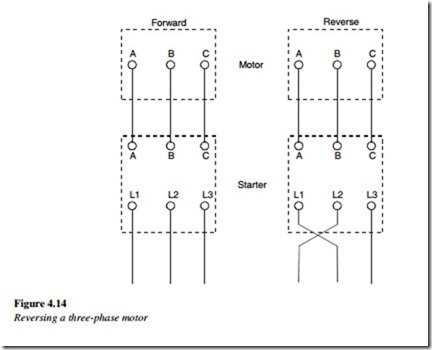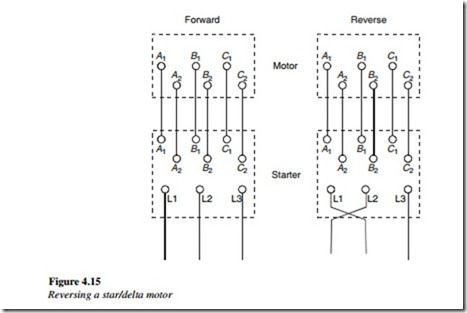Operating a motor for forward and reverse operation
Induction motor
In certain applications like lifts, cranes, etc., it is required that the motor be capable of reversing. This requires a reversible motor, i.e., one in which the shaft has a bi-directional rotation, both clockwise and anti-clockwise. In the induction motor, this is quite simply achieved by changing over any two of the leads.
In Figure 4.14, the direction of an induction motor with DOL starter is reversed. Phases L1 and L2 are interchanged; you can always change direction of the induction motor by interchanging any two phases. In larger ratings of motors the cooling fans may be suitable for one direction of rotation only. If bi-directional operation is anticipated, the same should be specifically stated to the manufacturer while ordering.
This can be achieved by changing the leads, either at the motor terminals or at the starter end connection. It is always advisable, to make changes to the lines going to the starter, as there may be some confusion in case of motors arranged for star–delta starting while making changes at the motor terminals.
In Figure 4.15, reversing connections of a three-phase induction motor with star–delta starter are shown. Phases L1 and L2 are interchanged; you can always change direction of the induction motor by interchanging any two phases.
As discussed earlier, it is advisable to make changes in the lines going to the starter. There may be some confusion, in the case of motors arranged for star–delta starting, while making changes at the motor terminals.
DC motors
In case of a DC series motor, the direction of the motor can be reversed either by changing the direction of the armature current or the field current.
In the same way for a shunt motor, the direction of the motor can be changed either by changing the direction of the armature current or field current. In the case of a compound motor, the direction of rotation can be reversed by changing the direction of the armature current or of both field currents, i.e., series and shunt field windings.
The industrial standard, however, is to change the armature current direction, keeping the direction of current in the field unchanged.
This is shown in Figure 4.16. At the motor terminal box, the starter cable is changed from A to AA, and the interconnecting link is changed from Y to AA. Any type of DC machine can be reversed by reversing the current flow in the armature and interpoles. It should be noted that the brush position might need to be changed to suit the new rotation.

